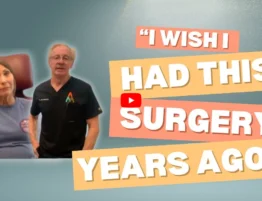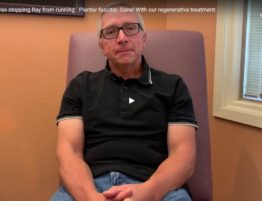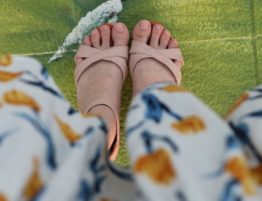For most people, restless leg syndrome would be overwhelming enough to deal with by itself, but Wade had restless leg syndrome and dropfoot, a condition that makes it hard to lift your toes or move your feet from side to side. Here’s his story, and how one procedure solved both of his problems.
No Sleep, No Solutions
“Every night when it was time to sleep, my legs would start twitching and jerking, and it was a violent type of jerk that would wake up my wife. I would get up and walk around and stretch. It kept both of us awake at night.”
Like many people struggling with restless legs, Wade searched for remedies online. “I don’t like to take medications or drugs, so I tried essential oils and magnesium oil, but nothing really worked,” Wade says.
Sick and Tired
Wade had dealt with these symptoms for nearly 6 years. He was having difficulty walking at work, experiencing sleep deprivation and didn’t want it get any worse.
Finally, he had enough. “You just think you have to live with something like this and so you learn to deal with it,” Wade says. “But finally you get sick and tired of being sick and tired and just decide to find a solution.”
Two Problems, One Treatment
Wade made an appointment to see Dr. James Anderson, DPM, and was pleased to find out that both his dropfoot and restless leg syndrome could be improved with one simple procedure.
Dr. James Anderson, DPM, explains “We believe that the source of both of these conditions comes from nerves becoming compressed in the legs. We perform nerve decompression surgery, and go in and open up those nerve tunnels, and many patients find relief from their symptoms very quickly after the surgery.”
The surgery takes about 45 minutes, and patients are able to walk the day after, so downtime is minimal. “I saw Dr. Anderson on a Monday, and was scheduled for surgery on Wednesday. I was just ready to get it done,” Wade says.
Intraoperative Nerve Monitor
Dr. Anderson says “We use an intraoperative nerve monitor that monitors progress during surgery, and it allows us to see how the nerve function is actually improving.”
The surgeon takes a baseline number of the nerve function before starting the surgery, and then again once surgery is complete and the nerve tunnels are open.
“For example, in Wade’s case, his baseline number was 11,976. By the end of the surgery it was 13,539, so we were able to tell him right after the surgery that his nerve function had improved,” says Dr. Anderson.
Watch Wade’s surgery in the video above.
Life Today
6 weeks after the surgery, Wade came in for an office visit. He reported that his dropfoot symptoms had already improved by 80-85% and his restless legs had improved by 90%.
“My wife and I can sleep through the night. I’m able to go for walks again and resume my normal activities,” says Wade.
His advice for others experiencing similar symptoms is this, “Don’t wait so long to take care of this. You don’t have to suffer and let your symptoms ruin your life. This can be fixed. Just make an appointment and see what they can do for you. My experience has been wonderful.”
To learn more about how we treat restless legs, click here.
To make an appointment, click here.









Write a comment: